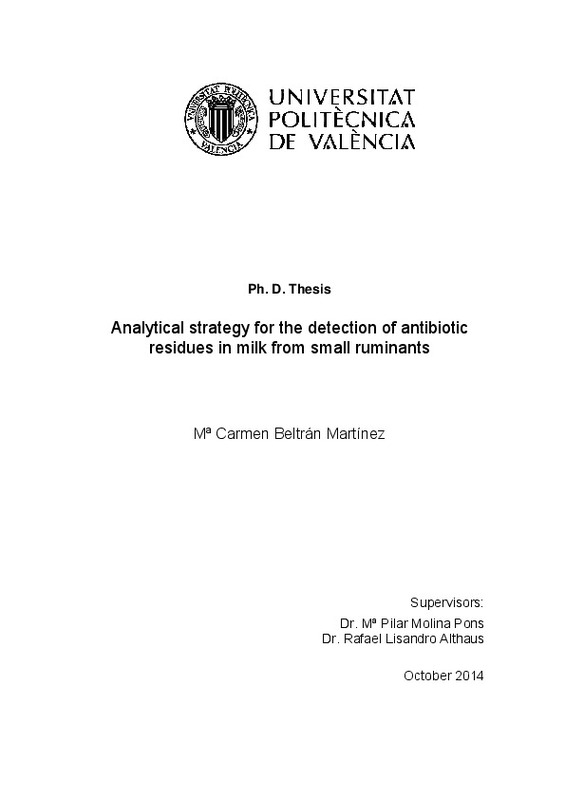|
Resumen:
|
In Mediterranean countries, sheep and goat’s milk production has traditionally been destined for the manufacture of cheese, often as raw milk. Cheese quality is closely related to milk composition but also to hygienic ...[+]
In Mediterranean countries, sheep and goat’s milk production has traditionally been destined for the manufacture of cheese, often as raw milk. Cheese quality is closely related to milk composition but also to hygienic aspects such as somatic cell count, bacteriology or presence of antibiotic residues, currently regulated by European legislation.
The implications of the presence of antibiotic residues in milk as a result of veterinary treatments include negative effects on consumer’s health such as allergies or antibiotic resistance and problems on the manufacturing processes of fermented products. For the screening of milk samples for antimicrobial residues, there are various methods available, microbial inhibitor tests and assays based on specific receptors, both widely used, especially in farms, the dairy industry and control laboratories. Screening methods have been validated for the use in raw milk from cows, but information on the performance of these tests in sheep and goat’s milk is rather limited.
The aim of this study was to evaluate the performance of some microbial and receptor-binding screening tests to detect antibiotics in sheep and goat’s milk according to Commission Decision 2002/657/EC to determine their suitability to monitor the presence of antibiotic residues in milk and establish the most convenient analytical strategy in Spain.
The Detection capability (CCβ) of microbial screening tests, the BRT MRL, the Delvotest MCS SP-NT, the Delvotest MCS Accelerator and the Eclipse 100, was at or below the maximum residue limits (MRLs) for most beta-lactam antibiotics assessed and other non-beta-lactam drugs such as neomycin, tylosin, sulfadiazine and sulfadimethoxine. However, they were less sensitive in the detection of quinolones and tetracyclines at safety levels. When individual milk samples were analysed, microbiological tests showed a higher occurrence of non-compliant results in sheep milk than in goat’s milk, being related in all cases to an elevated somatic cell count (SCC).
The microbiological system consisting of two complemetary microtiter plates containing Geobacillus stereathermophilus var. calidolactis and Bacillus subtilis, respectively, allows improving the detection level in sheep milk with respect to the use of a single commercial test using G. stearothermophilus, detecting some quinolone and macrolide substances more closely related to their respective MRLs.
The rapid receptor-binding assays (the Betastar Combo, the Charm MRL BLTET, the SNAP Betalactam, the SNAP Tetracycline and the TwinsensorBT) were able to detect most beta-lactams and tetracyclines at or below MRLs (CCβ ≤ MRL). A higher specificity of the rapid receptor tests was obtained in all cases even when individual milk samples were analysed. Only the TwinsensorBT test presented non-compliant results when antibiotic-free milk samples from individual animals were analysed, especially in the last weeks of lactation. No cross-reactions were found when drugs belonging to antimicrobial groups other than beta-lactams or tetracyclines were present in milk. Azidiol, used as a preservative, had no effect on the performance of the rapid receptor tests. Moreover, differences between the visual and instrumental classification of the test results were not found.
Taking into account the frequency of use of antibiotics commonly employed in Spain and the screening test sensitivity at MRLs equivalent to antibiotic concentrations, total detection rates have been calculated. In general, the use of a single test allows detecting 62.8-82.4 % of the antibiotics employed. For sheep milk, the total detection range achieved with microbial tests was significantly higher than that reached with rapid receptor tests. However, no significant differences between the two types of tests were found when goat's milk was analysed. In both types of milk, the simultaneous use of two screening tests with a different analytical basis increases the total detection range significantly, reaching values ≥ 90 % in some cases.
However, antibiotics such as enrofloxacin, marbofloxacin, spiramycin, and streptomycin also used to treat mastitis and other infectious diseases could not be detected by the screening tests assessed. Therefore, the improvement of the analytical strategy through the periodical implementation of screening tests able to detect these substances at safety levels would be recommended.
[-]
|







![MS Word file [Word]](/themes/UPV/images/msword.png)


